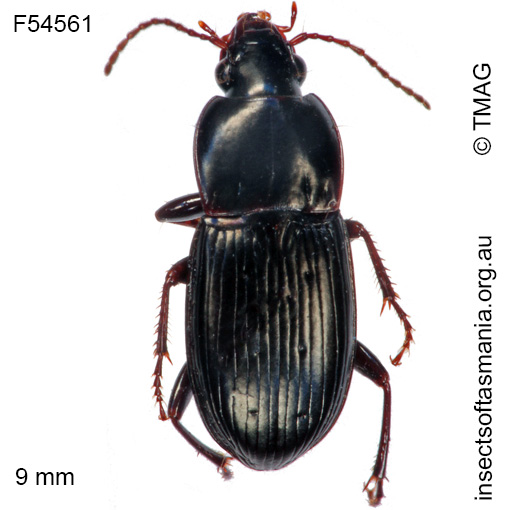
Simodontus australis
Basis for Tasmanian occurrence
TMAG collections
Classification
Suborder: Adephaga
Superfamily: Caraboidea
Family: Carabidae
Subfamily: Harpalinae
Tribe: Pterostichini
Morphology
Flightedness: winged and assumed capable of flight
Source literature on morphology and taxonomy (*primary taxonomic source, where identified):
Sloane, T.G. (1920). The Carabidae of Tasmania. Proc. Linn. Soc. NSW 45: 113-178.
Ecology
Association with dead wood or old trees: at least facultatively saproxylic
Ecological attributes: — Affiliated with mature (unlogged) forest (Michaels, 1999) — Affliliated with young (ex-clearfelled) forest (Grove, 2009) — Found under large logs (Grove et al., 2006) — Native grassland can be suitable habitat (Michaels, 1999b).
Collection method(s) for TFIC material: — Baited trapping (funnel trap) — Hand collection from under log of Eucalyptus sp. — Pipe trapping — Pitfall trapping.
Source ecological literature:
Grove, S.J. et al. (2006). What lives under large logs in Tasmanian eucalypt forest? Tas. Nat. 128: 86-93.
Grove, S.J. & Yaxley, B. (2005). Wildlife habitat strips and native forest ground-active beetle assemblages in plantation nodes in northeast Tasmania. Aust. J. Entom. 44 (4): 331-343.
Grove, S.J. (2009c). Do wildlife habitat strips act as refuges for mature-forest carabid beetle assemblages? A case-study in Tasmanian wet eucalypt forest, Australia. For. Ecol. Manage. 259: 496-504.
Michaels, K.F. (1999a). Carabid beetles as biodiversity and ecological indicators. PhD thesis, Univ. of Tasmania, Hobart.
Michaels, K.F. (1999b). Carabid … communities in Tasmania: classification for nature conservation. In: Ponder, W. & Lunney, D. (Ed.), The Other 99%: …. Roy. Zool. Soc. NSW, pp. 374-379.

